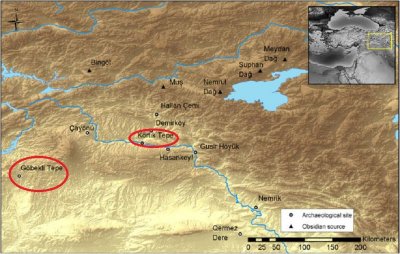Resubo el hilo. Enlazo en este por el tema de Gobekli Tepe, pero Hancock, megalitismo, aerqueologia, etc, etc andan desparramados por muchos hilos.
Sorry, tocho en ingles. Si alguien se anima a traducirlo....
Y mejor el enlace original por las fotos y videos que enlaza.
Mini Ice Age Wiped Civilisation 13,000 Years Ago
"El arqueólogo inconformista Graham Hancock insiste en que una civilización humana altamente evolucionada fue aniquilada por un desastre mundial hace unos 13,000 años.
Supongamos que todas las teorías más salvajes y la conspiración histórica del novelista Dan Brown resultaron ser ciertas. Y las afirmaciones de psíquico israelí Uri Geller, que leen la mente y hacen doblar la cuchara, resultaron ser verdaderas también.
Ese no sería un comentario sorprendente sobre el tema de una revista científica oscura, que es reivindicada por Graham Hancock.
Su insistencia en que está muy evolucionada civilización humana fue aniquilada por una catástrofe global recordado ahora sólo en los mitos y relatos bíblicos como la historia de Noé y el diluvio, ha-sido burlado y separados por expertos de corriente desde que habló por primera vez en la mitad de los 90¨.
Su último libro, Magicians Of The Gods, presentó hallazgos de todo el mundo en menor medida que en años anteriores, tras un ataque de cometa que causó terremotos y tsunamis devastadores.
Algunas de sus pruebas más convincentes, si bien bastante arcanas, fueron descubiertas en Gobekli Tepe, que literalmente significa Potbelly Hill. En este sitio cerca de la frontera con Siria, dijo Hancock, se encontró la obra más antigua de arquitectura monumental en la Tierra.
Su ingeniería era mucho más hábil que la de Stonehengue, además de 6000 años anterior. Las tallas e inscripciones astronómicas en las piedras sirvieron como ayuda para los observadores de estrellas prehistóricos, pero también contaron historias. Y uno era un cometa que cayó de los cielos, todo menos aniquilando a la raza humana.
A pesar de la minuciosa construcción del libro, que argumenta exhaustivamente cada punto, Hancock fue atacado con los usuales gritos de burla cuando Magicians Of The Gods apareció en 2015.
Su último libro, Magicians Of The Gods, presentó hallazgos de todo el mundo en menor medida que en años anteriores, tras un ataque de cometa que causó terremotos y tsunamis dvastadores.
Fue ridiculizado como un fanático, un entusiasta delirante y un hombre mucho mejor que fue empujado por su creencia desde hace mucho tiempo de que las drojas alucinógenas son estimulantes intelectuales. Esta tontería era arqueología para los hippies trippy, rieron los detractores de Hancock.
Entonces, cuando la investigación se ha realizado durante los últimos 20 años, puede que no sea sorprendente que el mensaje haya sido tan discreto como sea humanamente posible. Las esculturas de Gobekli Tepe sí describen un ataque de cometa, en 10.950 aC, dijeron algunos expertos serios y muy serios de la Escuela de Ingeniería de la Universidad de Edimburgo. Su informe apareció como un artículo en el poco conocido International Journal of Mediterranean Archaeology and Archaeometry, publicado por la Universidad del Egeo.
Pero la oscuridad de la fuente no puede ocultar la escala del retroceso científico. Las afirmaciones de Hancock suenan como una película de desastre de Hollywood, una película épica de ciencia ficción y un thriller de detectives, todo en uno. Sus teorías abarcan el significado de las pirámides y la futura destrucción del planeta.
Como el periódico Telegraph informa a los nuevos hallazgos científicos señaló: "La idea ha sido originalmente presentada por Graham Hancock en su libro Magicians Of The Gods".
Lo que no ha cambiado es el punto de partida para todas estas teorías. Justo después del 11,000 aC, los expertos han estado de acuerdo durante mucho tiempo, cuando la Era de Hielo, un evento catastrófico causó un cambio climático repentino e impactante. Esto marcó el comienzo de un gran frío conocido como Younger Dryas, que duró unos 1.500 años.
Los científicos tenían numerosas teorías para explicar este objetivo, en Magicians Of The Gods, Hancock comentó que teníamos más de 200 mitos antiguos, pertenecientes al Ártico al ecuador, que hablaban de una civilización humana avanzada. inundación y fuego.
A esto se agrega una evidencia física convincente, en forma de cantos rodados gigantes, depósitos de platino y diamantes diminutos que se encuentran en América del Norte: los detritus de un impacto colosal.
Había una sola explicación, dijo Hancock, y coincide con la cuenta de los pilares de piedra caliza en Gobekli Tepe. . . una cuenta ahora verificada por el equipo de la Universidad de Edimburgo.
Nuestro planeta fue golpeado por un cometa. Un asteroide ardiente se precipitó desde el firmamento y golpeó con la fuerza de varios miles de bombas nucleares estallando simultáneamente. Eliminó a muchas especies, incluidos el mamut lanudo y el oso perezoso, y casi destruyó a la humanidad. Algunas personas sobrevivieron, incluyendo los antepasados de la tribu Ojibwa de las praderas canadienses, que todavía cuentan la historia de la escalada qui Estrella Celestial havelda barrido del cielo para quemar a la tierra. Sus mitos cuentan que dejó atrás 'una diferencia"
(traductor automático...



